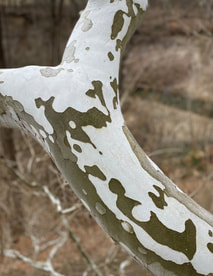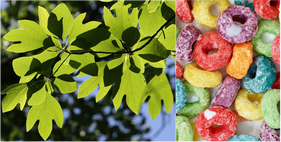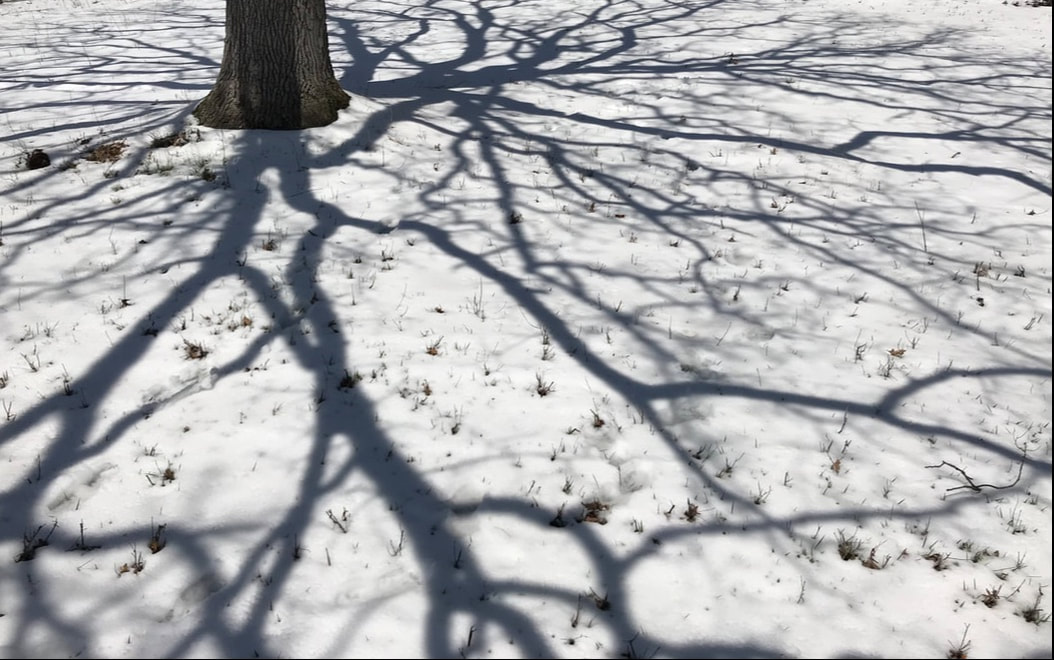|
Cold temperatures, shortened daylight hours, and lack of greenery can fool anyone into thinking there isn’t much reason to head outside in winter. It may seem like life and Nature have hit the pause button. Don’t be fooled. There is a lot going on out there! With less foliage present in the winter, there are many characteristics that become more apparent and less obscured by the sensory overload during the growing season. If you are not sure of what you are looking for, all you need to do is get out there and let your senses be the guide. SIGHT Fall leaf color is one of the more noticeable aspects of trees that people enjoy. One study estimated a 30-billion-dollar annual contribution to the tourism industries of the 24 states in the eastern U.S. alone. While the fall color change can be enjoyed through the windshield, there are many more details to enjoy when you slow down and spend time in the presence of a tree. Branches twist and wind their way to openings where their leaves can capture sunlight. This winding nature of the branches leads to an artistic framework. The abstract patterns can be enjoyed from a number of angles and perspectives, such as when winter leaf drop exposes the branching structure of deciduous trees. Bark color and textures vary greatly between species. River birch’s bark layers peel and curl along the trunk, revealing salmon colored inner bark. This attractive coloration and unique look make it a popular tree in landscapes. It may take on added winter interest if you do a little reading on a potentially useful characteristic of birch bark. Birch bark contains a compound that repels water, keeping the tissue dry. It is also flammable. A perfect combination when needing to start a campfire.  Sycamore's unique bark pattern Sycamore's unique bark pattern I particularly enjoy the texture, colors, and patterns of sycamore bark. The flaking bark leaves behind an evolving camouflage pattern formed as the green, gray, and tan papery layers exfoliate to reveal bright white inner bark on stems. In late winter, as we begin to anticipate the coming spring weather, the tiny leaf buds begin to swell and provide an early hint of the colorful season to come. This slight coloration is seen in the tops of the trees, contrasting against the brown and gray branches and blue skies. As winter draws to a close, we can enjoy the hint of red atop silver and red maples as well as the vibrant yellow cast along weeping willow twigs.. TOUCH In Wisconsin we are fortunate to have northern white cedars. They make my personal top-ten list of favorite tree barks! As northern white cedars age, their bark shreds into thin linear strips that run up and down the trunk. It has a slightly spongy feel in the outer layers of bark if you press into it with your fingertips and feels soft to the touch as you run your fingers along. There are numerous areas where we can get out and enjoy northern white cedar across Wisconsin, with one of my favorite areas being Newport State Park in Door County. Closer to my home in Waukesha County, Retzer Nature Center has a few groves of cedars around the park, one of which forms the centerpiece of the parking lot. Even your feet will notice the soft, cushiony feel of the leaf litter blanketing the ground under a grove of northern white cedar. You can enjoy their bark at any time of year, but spending time with them in winter has far greater impact for me as they maintain their green foliage through the winter. Immersing myself in a canopy of green when brown and gray dominate the winter color spectrum is like a breath of fresh air. SMELL I can seldom pass on the opportunity to bend down and smell a flower in bloom. Some have little to no fragrance. Some are enjoyable and others might not be so pleasant. Regardless, the experience of stopping to smell the flowers pulls me into the present moment. Even with the lack of flowers in the winter months, there are a few trees that I have a hard time passing by without taking in their pleasant fragrance. Some may have soothing effects and others I find energizing.  Nestled in the branches of a spruce, immersed in the pleasant scent Nestled in the branches of a spruce, immersed in the pleasant scent Several of our coniferous evergreens stimulate my sense of smell on winter hikes. Northern white cedar and eastern white pine are two of my favorites. Hemlock and spruce also do the trick. Walking near any one of these trees is likely to awaken your sense of smell. One place I enjoy immersing myself in these aromatic compounds is along the Ice Age Trail in Hartman Creek State Park. As the trail winds through rolling, forested terrain of oak, pine, and maple, you pass through pockets of spruce & hemlock. Even if you are not able to identify them by name, your nose will surely let you know it is time to slow down and breathe it all in! The essential oil and aromatherapy industries promote these compounds for their beneficial effects on us; like relaxation, invigoration, enhancing concentration, decreasing hyperactivity, reducing stress, easing tension, and clearing the mind. I use them in diffusers at home and in my office; but they are no substitute for heading out and enjoying them right from the source! SOUND I enjoy the distinct crunching sounds underfoot during a winter hike. Whether the trail is lined with fallen oak leaves or covered in freshly fallen snow, neither of these unique sounds were something I experienced while growing up in Puerto Rico and southern Florida. Another one of the sounds I go in search of in winter leads me to stands of eastern white pine. Not only does the foliage dampen the stark sounds from traffic and other noise pollution sources, the fine and feathery texture of the needles emit a soothing “whoosh” as the breeze passes through. Pair this calming sound with the soft texture of the needles and pleasant aroma and you may be able to understand why sitting on a branch near the top of an eastern white pine is one of my favorite places to be! TASTE Tastes related to trees is most readily appreciated by tasting the fruits, seeds, and nuts. Therefore, this sense is more commonly enjoyed during the growing season as opposed to winter. One of my favorite tasting experiences was the day I sat along the bank of a tributary to the Des Moines River in central Iowa. I was sitting amongst a stand of black walnut trees in late summer as leaves and walnuts fell around me. I’ve never cared for store bought walnuts (which are English walnuts), yet given the abundance of nuts I decided to try one. It was the best tasting nut I’ve ever tasted. The tenderness of the nut and the bold flavor, wow! I spent the afternoon feasting upon freshly fallen nuts and watching the river flow past as the sun sank closer to the horizon. Since most of the edible fruits have fallen, rotted, or been consumed by animals come winter, I resort to enjoying a variety of tastes from various twigs. Some species have a distinct taste and often used by knowledgeable professionals as an aid in identification.  Crushed leaves and bark of younger twigs has a pleasant aroma of Froot Loops! Crushed leaves and bark of younger twigs has a pleasant aroma of Froot Loops! Black or sweet birch is known for its wintergreen taste, black cherry for its somewhat cherry or almond-like taste, and sassafras has flavors of spiced fruit. Since some of these species may also contain low levels of toxic compounds when ingested, you may opt for the alternative experience of scraping the bark of fresh twigs to reveal the aroma. Sassafras has a fruity aroma like that of Froot Loops! Using the sense of taste should be approached with caution. Even if a particular plant is known to be edible, it may still contain toxic compounds, certain people may have a sensitivity, or there may be similar looking plants that may be toxic. SENSORY JOURNEY
While we may spend more time indoors during the winter months, there are plenty reasons to get out and enjoy the season. If not just to get out in the sunshine or bathe in the green colors of pines, spruces, and other evergreens, I'm also drawn outside to witness the unique aspects visible in winter and appreciate the different experience they provide. Acknowledging and engaging in the changing of the seasons helps to build layers of memories, can strgengthen your emoitonal attachment to a place, and grow your appreciation of life.
0 Comments
Leave a Reply. |
AuthorAs a G.O.T.C. Recognized Master Instructor & Facilitator, I.S.A. Board Certified Master Arborist, and T.C.I.A. Certified Treecare Safety Professional, Curt has spent over 30 years dedicated to the study and care of trees. Categories
All
Archives
April 2024
|
|


 RSS Feed
RSS Feed
